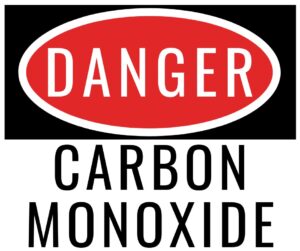11 Heating & Carbon Monoxide Safety Tips
Carbon Monoxide is often called “the silent killer” because even though it is odorless, colorless, and tasteless it is still quite poisonous and very deadly. Hundreds of people die accidentally each year from carbon monoxide. The main causes of these poisonings are often poor building ventilation and improperly using fuel-burning appliances. As the weather gets colder, and more heating is required, we need to be sure we’re heating our homes, offices, and factories safely. Carbon Monoxide Safety is one of the most important things in a large industrial environment.
Dangers of Carbon Monoxide

Carbon monoxide (CO) comes from burning fuels such as gasoline, wood, coal, natural gas, propane, oil, and methane. Basically, anything you might use to keep warm in the winter. It is a result of the partial oxidation of carbon-containing compounds and forms when there is not enough oxygen to produce carbon dioxide.
CO becomes toxic to humans when encountered at 35 PPM. It enters the lungs and blood where it competes with oxygen normally carried by red blood cells. CO attaches to the cells two hundred times easier than oxygen and without oxygen, the cells begin to die.
Exposure to CO can produce flu-like symptoms such as Headaches, Nausea, Dizziness, Confusion, Fainting. Higher levels of CO exposure can lead to unconsciousness and death. If you suspect CO exposure, you should get out of the area, car, space etc. and get to fresh air. If you have any of these symptoms, seek medical help immediately.
11 Tips for Carbon Monoxide Safety
National Fire Protection Association suggests the following carbon monoxide safety tips
- CO alarms should be installed in a central location outside each sleeping area and on every level of the home and in other locations where required by applicable laws, codes, or standards. For the best protection, interconnect all CO alarms throughout the home. When one sounds, they all sound.
- Follow the manufacturer’s instructions for placement and mounting height.
- Choose a CO alarm that has the label of a recognized testing laboratory.
- Call your local fire department’s non-emergency number to find out what number to call if the CO alarm sounds, assist everyone out of the building via the fire safety door.
- Test CO alarms at least once a month; replace them according to the manufacturer’s instructions.
- If the audible trouble signal sounds, check for low batteries. Replace low batteries. Call the fire department if you replace the batteries and the device is still making noise.
- If the CO alarm sounds, immediately move to a fresh air location outdoors or by an open window or door. Make sure everyone inside the home is accounted for. Call for help from a fresh air location and stay there until emergency personnel arrives.
- If you need to warm a vehicle, remove it from the garage immediately after starting it. Do not run a vehicle or other fueled engine or motor indoors, even if garage doors are open.
- During and after a snowstorm, make sure vents for the dryer, furnace, stove, and fireplace is clear of snow build-up.
- A generator should be used in a well-ventilated location outdoors away from windows, doors, and vent openings.
- Gas or charcoal grills can produce CO – only use these items outside.
Common CO Sources
CO poisoning is such a danger because it is everywhere in our modern lives. For that reason, you need to know where CO is, and how to be safe around it. Some common sources of CO are:
- Furnaces and water heaters
- Chimneys and wood stove oil-fueled
- Gas and space heaters (a large contributor to CO poisoning in the US)
- Blocked furnace and dryer vents
- Car tailpipes (they must be open, without snow or mud blocking the pathway)
- Generators
- Running vehicles
- BBQ grills and camping stoves
- Gas ovens used for heat
- Gas tools such as snow removers and powered yard equipment
Space Heaters & Indoor Use CO Devices
There are some misconceptions about “indoor use” space heaters and fuel burning appliances. Even “indoor” space heaters must be in spaces with proper ventilation.
Proper ventilation is key in the industrial space. With gas powered forklifts, generators, and heavy equipment operating in enclosed places, CO is a common danger. Open air ventilation is just one way to help prevent CO build-up. Audit your building and install CO detectors to avoid exceeding the 35-ppm limit. With a free industrial ventilation design from Moffitt, you can be on your way to a more breathable and safer building.
Know your carbon monoxide safety tips to make sure your plant is worker friendly.
